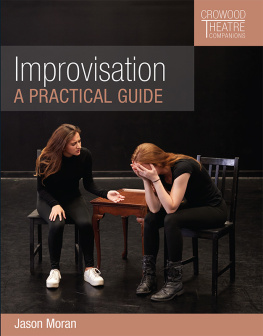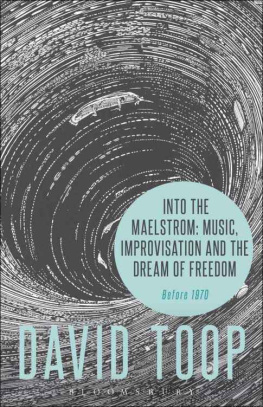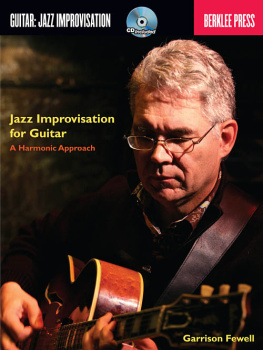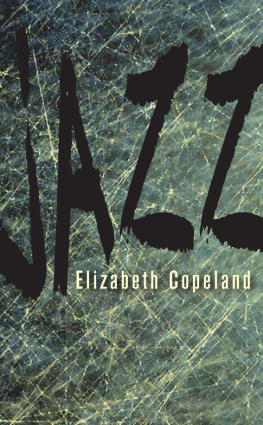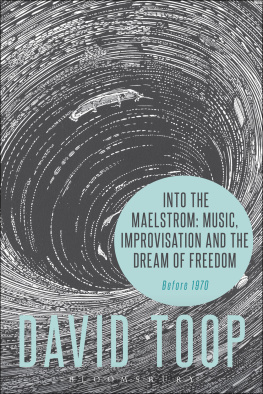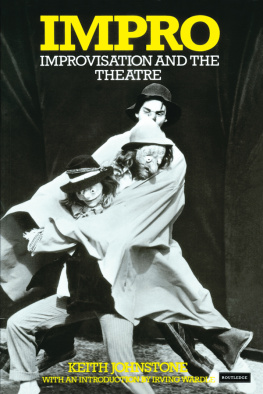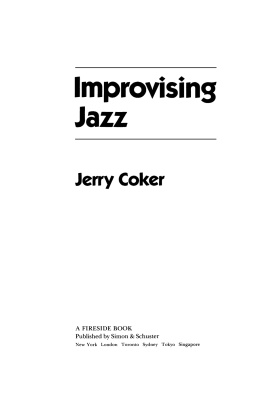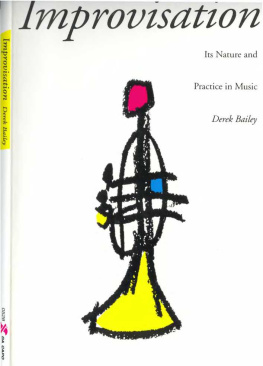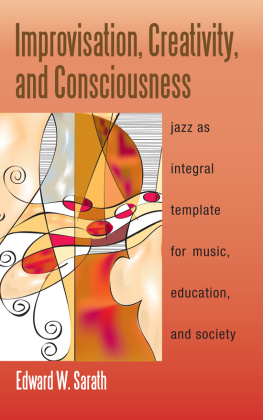John Abbott

THE IMPROVISATION BOOK
How to Conduct Successful Improvisation Sessions

NICK HERN BOOKS
London
www.nickhernbooks.co.uk
Contents
For Jane
Authors Note
I WORKED AS AN ACTOR FOR MOST OF MY LIFE IN ALL AREAS of the profession. At one time I was a member of the Royal Shakespeare Company and at another time I was the vicar in Emmerdale Farm. I still get royalties and fan mail for my appearance in four episodes of Doctor Who in the seventies and I spent twenty minutes in front of the camera filming a scene for Four Weddings and a Funeral.
A high point in my acting career was touring The Tempest with Mark Rylances company Phoebus Cart and a low point was having to quack like a duck to sell toilet cleaner on Dutch television. Between a mixed bag of professional jobs I have been involved in quite a lot of poorly paid artistic and/or experimental performance projects, a few of which could possibly have altered peoples theatrical expectations.
Then I gave up acting and started teaching. As ever, the elders of the tribe pass on their survival skills to the younger generation.

I would like to thank all the students I have ever taught for their energy and enthusiasm in my classes. I experimented with some bizarre prototype Improvisation Cards, and my students always tried to make them work they were even positive about some of my less-successful home-made games and exercises. Thanks for that.
I would also like to thank Amanda Brennan because she was the one who said, Come and teach Improvisation at the Kensington and Chelsea College when I had absolutely no experience.
And, of course, special thanks to Jane Harrison, without whom...
Then, if it wasnt for Nick Hern, this book would have been a confused mess. Thanks for such detailed work, Nick (and for the grammar lesson). Thanks also to everyone else at Nicks place for their different skills, particularly Matt Applewhite who has kept me focused and on track.
J OHN ABBOTT
Introduction
I FIRST BECAME AWARE OF THE POTENTIAL OF IMPROVISATION when I saw Dustin Hoffman in the film Midnight Cowboy. There he is with his full-flight characterisation of Ratso, hobbling down a street in New York, smoking a cigarette and jabbering his streetwise scripted lines very truthfully and animatedly to Jon Voight. This scene is filmed with a long lens the type that is like a telescope and makes it look as if the actors are hardly moving towards you at all. In fact, the camera is so far away that the people on the street arent even aware that any filming is taking place. Suddenly, just as the two actors are crossing a side street, a yellow cab lurches into view and jams on its brakes to avoid hitting them. Without breaking concentration, Dustin Hoffman turns round and hits the bonnet of the cab; his cigarette flies out of his mouth; he gestures wildly and shouts, Hey... Im walkin here... Im walkin here... Up yours, you sonofabitch. The cab driver starts to shout back at him and Hoffman yells, You dont talk to me that way... Get out of here. He then turns back to Jon Voight, grabs him by the arm to keep him walking and says, Dont worry about that... Actually, that aint a bad way to pick up insurance, you know. And they carry on down the street. Its a magic moment, because the audience senses that something real has just happened and that they have observed uncontrived, unrestrained life, and it is exciting and stimulating.
The only film Dustin Hoffman had made before Midnight Cowboy was The Graduate in which he played a character in his early twenties. Dustin Hoffman was over thirty at the time, having spent ten years or so working in theatres in New York. Some of this theatre work had used explorative rehearsal techniques such as improvisation, so when he appeared to be nearly knocked down by that cab in Midnight Cowboy, rather than abandoning the shot, his improvisation skills clicked into place: he kept in character; he carried on talking; he made up his own script; and as a result the scene took on a new and unexpected life.
The ability to improvise allows the actor to stay in the moment whatever might happen.
Of course, we have all become used to hearing improvised dialogue in films even if we arent aware of it. The technique was explored during the sixties and seventies by the American actor/director, John Cassavetes, in his low-budget, independently produced films like Faces, Shadows and Husbands, in which he often used improvisation to create dialogue. More recently, the British director Mike Leigh has constructed his films by using his actors improvisation skills to create characters, invent dialogue and explore relationships from which he and they ultimately construct a plot. He has created some outstanding work using this method, including Abigails Party, Secrets and Lies and Vera Drake.
So What is Improvisation?
Apart from its use in theatre and film, perhaps the word is most commonly associated with music. Indian classical music, for instance, is based on the raga, where the musicians improvise round a given set of notes; folk music is often improvised round a central theme, both melodically and lyrically; and, of course, jazz relies heavily on the musicians ability to explore and improvise around both the melody and the chord structure of a tune. When musicians improvise they decide the notes they are going to play at more or less the same moment that they play them. They are not reading the music from a page, they are making it up as they go along. They are improvising. But whatever notes they decide to play, there is usually a strong musical framework for them to improvise within. A structure. A set of rules that must be obeyed. Sometimes these rules are bent; sometimes they are abandoned for a while; sometimes they are abused and scorned; but they are always there, lurking beneath the surface, holding everything in place. For without rules we tend towards anarchy.
And the joy of musical improvisation is twofold. In the first instance, the musician is allowing the Muse to take over. He or she finds that the music sometimes seems to write itself, the improvised tune appears out of the blue and can be more inspired and beautiful than a tune that is painstakingly crafted. And in the second instance the audience is observing a moment of artistic creation as it actually takes place. They are there at the time, and the joy of artistic creation is shared between the musician and the audience. It is a shared emotional experience. It can make you laugh or it can make you cry. It can be exciting; it can be moving; it can be shocking; but whatever emotion it inspires, it is alive. It is life itself.
And what is the actor trying to achieve in performance if it isnt life itself ?
There are several ways that improvisation can be used in the context of acting. We are familiar with the idea of actors improvising in front of an audience from television programmes like Whose Line Is It Anyway? This form of improvisation is often known as Theatre Games or TheatreSports and is usually performed by two or three comedians who are given a set of circumstances and/or characters from which to create a few minutes of improvised entertainment that can often turn into wild, anarchic comedy. The audience is continually aware that the actors are performing, and the joy lies in seeing how witty and imaginative their creations can be. Truth is often abandoned in favour of knockabout humour and funny lines. The actors who improvise in this way are often very skilful performers with strong imaginations and a powerful sense of danger, and the results can be wildly entertaining. However, TheatreSports is not the kind of improvisation technique I will be discussing in this book.

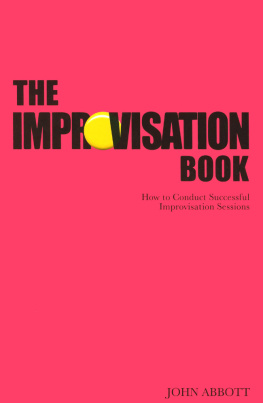
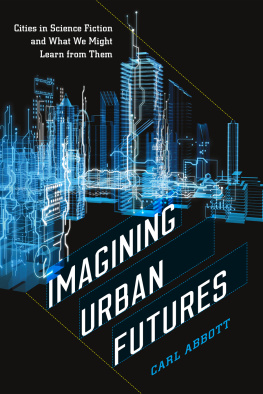
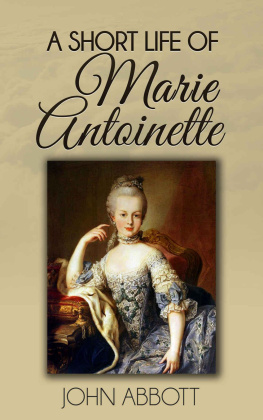
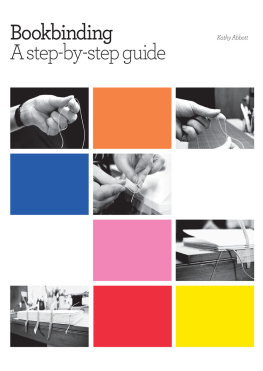
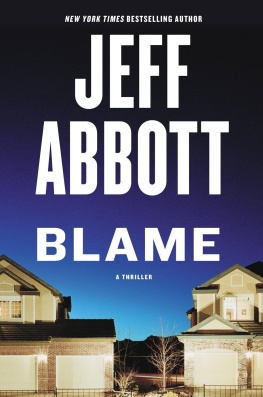
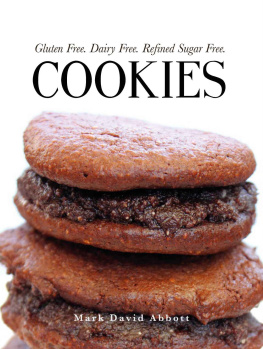
![Viola Spolin - Improvisation for the Theater: A Handbook of Teaching and Directing Techniques [1963 ed.]](/uploads/posts/book/406435/thumbs/viola-spolin-improvisation-for-the-theater-a.jpg)
